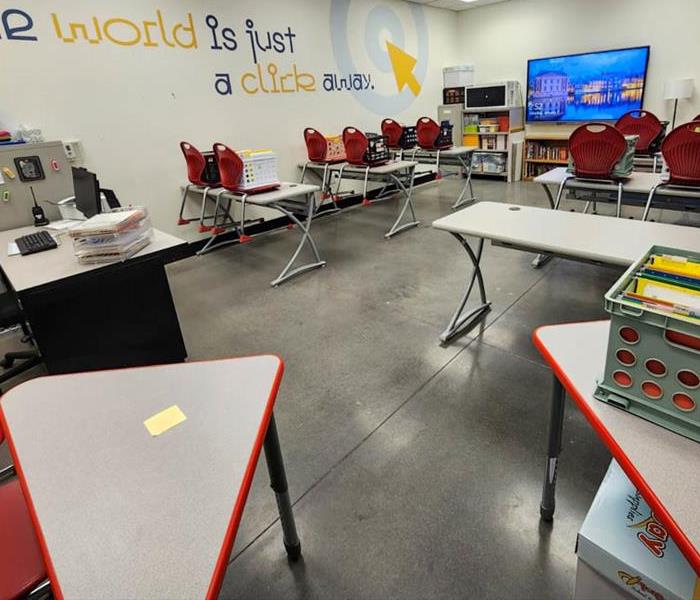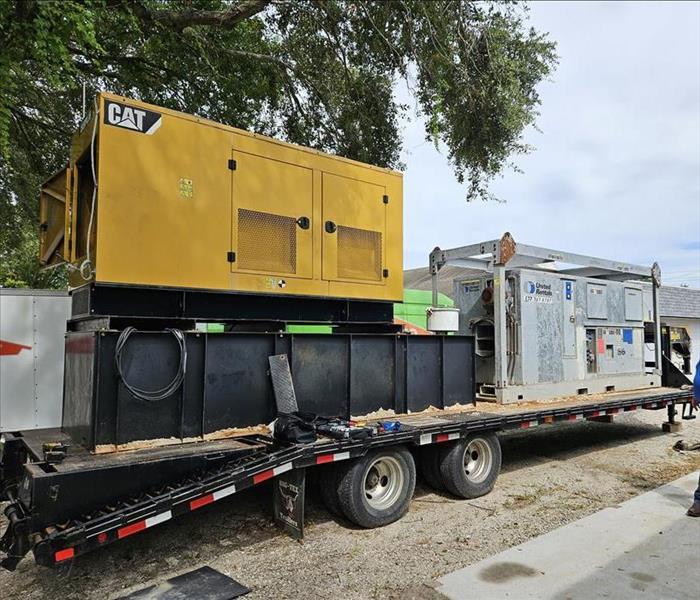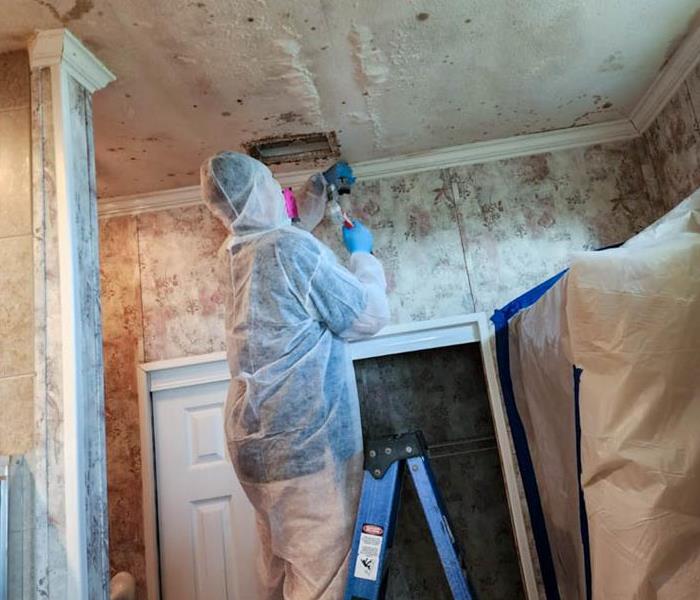Archived Mold Remediation Blog Posts
How long before mold develops in a leaking roof?
11/13/2024 (Permalink)
 By acting quickly, you can save time, money, and protect your home from long-term structural damage.
By acting quickly, you can save time, money, and protect your home from long-term structural damage.
Roof leaks can be a homeowner’s worst nightmare, not only because of the water damage they cause but also due to the risk of mold growth. If left unchecked, a leaking roof creates the perfect environment for mold to thrive. But how long does it take for mold to develop once a leak begins? Let’s dive into expert insights and what you need to know to protect your home.
How Quickly Can Mold Develop?
Mold can start growing in as little as 24 to 48 hours after a leak begins. This timeline is significantly impacted by factors such as the size of the leak, the temperature, and the humidity levels in your home. A moist, humid environment speeds up mold growth, especially in hidden areas like attic spaces or within your walls. The rapidity of mold growth makes it crucial to address roof leaks as soon as they’re discovered to prevent further damage.
According to the Federal Emergency Management Agency (FEMA), "mold can grow within 24-48 hours after water exposure" and will continue spreading unless moisture is controlled.
Key Areas Vulnerable to Mold Growth
When your roof leaks, water can seep into various parts of your home, creating the perfect breeding ground for mold. Be sure to check the following areas:
- Attic and insulation: Water trapped in insulation can easily go unnoticed, providing mold with the ideal environment to grow.
- Walls and ceilings: Water can move down walls or pool in ceilings, creating hidden pockets of moisture.
- Wooden structures: Mold thrives on organic materials like wood, and the framing in your roof or attic can quickly become compromised.
Signs of Mold Growth from a Roof Leak
Addressing mold early is key to minimizing damage. Here are some common signs that mold may be growing due to a roof leak:
- Visible mold spots on ceilings or walls
- Musty odors in areas near the leak
- Discolored patches or water stains on surfaces
How to Prevent Mold from Developing
To prevent mold from developing after a roof leak, follow these steps:
- Fix leaks immediately – As soon as you notice a leak, have it repaired to prevent water from infiltrating your home.
- Dry affected areas – Use fans, dehumidifiers, or professional drying equipment to remove moisture.
- Inspect regularly – Perform routine roof inspections, especially after storms, to catch leaks before they cause further issues.
At SERVPRO of NE Hillsborough/Plant City, we specialize in water damage restoration and mold remediation. If you suspect mold growth from a leaking roof, don’t wait. Our team has the experience, expertise, and equipment to handle the situation professionally and prevent further damage.
By acting quickly, you can save time, money, and protect your home from long-term structural damage.
Mold Removal vs. Mold Remediation: What's the Difference?
3/13/2024 (Permalink)
 When it comes to dealing with mold in your home, it's important to understand the difference between mold removal and mold remediation.
When it comes to dealing with mold in your home, it's important to understand the difference between mold removal and mold remediation.
When it comes to dealing with mold in your home, it's important to understand the difference between mold removal and mold remediation. While these terms are often used interchangeably, they refer to distinct processes. In this blog, we will explore the differences between mold removal and mold remediation, shedding light on the appropriate approach to address mold issues effectively.
Mold Removal: A Temporary Solution
Mold removal, also known as mold cleanup or mold abatement, refers to the process of physically removing visible mold growth from surfaces. This process typically includes wiping, scrubbing, or vacuuming affected areas to eliminate visible mold.
While mold removal can effectively get rid of existing mold growth, it does not address the underlying cause of the mold issue. Without eliminating the moisture problem or source of humidity, mold is likely to reappear in the future. Therefore, mold removal alone is considered a temporary solution and does not provide long-term protection against mold recurrence.
Mold Remediation: A Comprehensive Approach
On the other hand, mold remediation takes a more comprehensive approach. Mold remediation focuses not only on removing mold growth but also on addressing the underlying causes and preventing future mold problems.
Mold remediation involves the following steps:
- Assessment: Trained professionals inspect the affected area to identify the extent of mold growth, sources of moisture, and potential hidden mold.
- Containment: To prevent the spread of mold spores, technicians isolate the affected area using physical barriers and negative air pressure systems.
- Filtration: High-efficiency particulate air (HEPA) filters are used to capture and remove mold spores and other particles from the air during the remediation process.
- Mold Removal: Mold-affected materials that cannot be salvaged are safely removed and disposed of. The remaining surfaces are thoroughly cleaned and treated with antimicrobial agents to inhibit mold growth.
- Moisture Control: Professionals address the moisture problem by repairing leaks, improving ventilation, or implementing appropriate drying techniques to ensure long-term prevention of mold growth.
- Restoration: Finally, mold restoration services restore the affected area to its pre-damage condition. This may involve repairing or replacing damaged materials, such as drywall or flooring.
The Benefits of Mold Remediation
Compared to mold removal alone, mold remediation provides several key benefits:
- Long-Term Solution: By addressing the underlying moisture issue, mold remediation helps prevent future mold growth, providing a more long-term solution.
- Comprehensive Approach: Mold remediation not only removes visible mold but also ensures thorough cleaning and treatment of affected surfaces, reducing the risk of mold recurrence.
- Professional Expertise: Trained professionals, such as those at SERVPRO, have the knowledge, experience, and specialized equipment necessary to effectively handle mold remediation.
- Property Restoration: Mold restoration services included in the remediation process help restore your property to its pre-damage condition, saving you time, money, and stress.
Mold Restoration Services
Understanding the difference between mold removal and mold remediation is crucial for effectively addressing mold issues in your home. While mold removal alone provides a temporary solution by eliminating visible mold growth, mold remediation takes a comprehensive approach by addressing the underlying causes, preventing future mold problems, and restoring your property.
When it comes to mold issues, it's best to consult professionals like SERVPRO® who offer mold remediation and restoration services. Their expertise and specialized equipment ensure that mold problems are handled thoroughly and effectively, providing you with peace of mind and a safe, mold-free living environment.
A Guide on How to Prevent and Eliminate Kitchen Mold
11/14/2023 (Permalink)
 For extensive mold problems, it's best to hire a professional mold remediation service.
For extensive mold problems, it's best to hire a professional mold remediation service.
Living in Florida comes with its fair share of moisture and humidity, which can create the ideal conditions for mold growth, especially in your kitchen. In this post, we'll discuss some practical tips to help you prevent and eliminate mold in your kitchen in the Plant City, FL area.
Understanding the Mold Threat in Plant City, FL
Plant City's warm and humid climate makes it a perfect breeding ground for mold. Kitchens, with their high moisture levels and organic materials, are particularly susceptible. Mold not only looks unsightly but can also severely damage your property.
Preventing Kitchen Mold
Ventilation is Key
Proper ventilation is essential for reducing humidity levels in your kitchen. Use exhaust fans, open windows, and run dehumidifiers to maintain healthy airflow. Ventilation is your first line of defense against mold growth.
Fix Leaks Promptly
Even minor leaks under sinks, around faucets, or in pipes can provide enough moisture for mold to thrive. Be vigilant about fixing leaks as soon as they're detected to prevent mold from gaining a foothold.
Regular Cleaning
Regularly clean your kitchen, paying attention to all surfaces and hidden areas. Mold can grow on countertops, backsplashes, and inside cabinets. Use mold-resistant cleaners and scrubbing tools to eliminate any existing mold.
Store Food Properly
Keep food items sealed and stored in airtight containers to prevent moisture buildup and mold growth. Inspect your pantry regularly for any signs of mold on food or shelves.
Eliminating Kitchen Mold
Identify the Source
If you discover mold in your kitchen, it's essential to determine the source. Mold often grows in hidden areas, like behind walls or under cabinets. Identifying the source will help you prevent its return.
DIY Cleanup
For minor mold issues, you can tackle the cleanup yourself. Use protective gear, like gloves and masks, and scrub the affected areas with a mixture of water and mold-cleaning solutions. Make sure to dry the area completely afterward.
Professional Remediation
For extensive mold problems or when it's beyond your comfort level, it's best to hire a professional mold remediation service. SERVPRO® of Northeast Hillsborough/Plant City offers expert mold removal services tailored to the local climate and conditions.
Mold in your kitchen can be a persistent issue in Plant City, FL, but with the right prevention and elimination strategies, you can keep your kitchen mold-free. Remember to stay vigilant, address any water issues promptly, and consider professional assistance when needed. By following these guidelines, you'll create a clean and safe kitchen environment for you and your family. If you require expert mold remediation, contact SERVPRO® for fast and effective solutions.
6 Tips for Controlling Mold Problems in Your Home
5/18/2023 (Permalink)
Mold is a common problem in many homes, especially in areas with high humidity levels or where water damage has occurred. If you have a mold problem in your home, it's essential to address it quickly to prevent it from spreading and becoming a more significant issue. In this blog post, we will discuss some tips on how to control mold problems in your home.
Identify the source of the moisture
Mold thrives in damp, humid environments, so the first step in controlling a mold problem is to identify the source of the moisture. This could be anything from a leaky roof to a burst pipe or even excessive condensation on windows. Once you have identified the source, you can take steps to fix it, which will help to prevent mold from growing and spreading.
Improve ventilation
Poor ventilation can contribute to mold growth by trapping moisture and preventing it from evaporating. To improve ventilation in your home, make sure that air can circulate freely through all rooms. You can also install exhaust fans in bathrooms and kitchens, which will help to remove excess moisture and prevent mold growth.
Clean up mold immediately
If you spot mold growing in your home, it's essential to clean it up as soon as possible. Use a commercial cleaning solution to clean the affected area thoroughly. Be sure to wear gloves and a mask to protect yourself from mold spores. Once you have cleaned the area, dry it thoroughly to prevent any moisture from remaining.
Use a dehumidifier
If your home is particularly humid, a dehumidifier can help to control mold growth by removing excess moisture from the air. This is particularly important in areas such as basements, which can be prone to dampness.
Keep your home well-maintained
Regular maintenance of your home can help to prevent mold growth by keeping moisture levels under control. This includes fixing leaky pipes and roofs, repairing any water damage as soon as it occurs, and regularly cleaning your home to remove any mold spores that may be present.
Monitor humidity levels
Monitoring the humidity levels in your home can help you to identify potential mold problems before they become too serious. You can purchase a humidity meter to keep track of the moisture levels in your home. Ideally, you want to keep the humidity level below 60%.
In conclusion, controlling a mold problem in your home requires a combination of identifying and fixing the source of moisture, improving ventilation, cleaning up mold immediately, using a dehumidifier, keeping your home well-maintained, and monitoring humidity levels. By following these tips, you can prevent mold from becoming a more significant issue.
What To Do with Belongings After Mold Removal
1/9/2023 (Permalink)
Mold is a serious problem for homeowners, especially when it grows inside of your home. But mold can also be difficult to remove from items like carpeting, upholstery and wood surfaces if left untreated for too long. If you have been exposed to mold in your home or business premises, you should clean and dispose of any items that may have been affected by the fungus growth as soon as possible after removing them from the area.
After removing the mold, should I clean or throw away my belongings?
If the mold has been removed from your belongings, there's no need to throw them away. If you can clean the items, do so. Cut up or remove any visible moldy parts of the item and then wash it thoroughly in hot water with detergent (to remove remaining spores) or a disinfectant product specifically designed for cleaning mold-contaminated items.
If an item cannot be cleaned (for example, if it is covered by carpeting), you should dispose of it in a sealed plastic bag containing dry ice or other desiccant to prevent further growth of mold inside the bagged area before placing it in an outdoor trash barrel or dumpster.
Why Should Items Be Disposed of After Mold Removal?
There are several reasons why it is imperative to dispose of the items after mold removal.
- Mold can be present in many places in your home, so you must keep an eye out for any signs of mold. If you see black or white spots on walls or ceilings, then you may have a mildew problem and should call a professional immediately.
- Mold spores are microscopic, and they float through the air waiting for something to land on - like your carpeting or furniture - so that they can grow into colonies.
How to Clean Items that Have Been Molded
After mold removal, it's best to clean items that have been moldy with a HEPA vacuum. You can use a stiff brush to remove any visible mold and then wash the item with hot water and detergent, then dry it in a dryer on high heat for 30 minutes or more.
If the item doesn't come out completely clean after this process, wipe down all surfaces with a vinegar solution (1 part vinegar:10 parts water) and let sit overnight before rinsing again. Finally, dry items completely before returning them to their original location.
How to Clean Up Following Mold Removal
Once the mold has been removed, it’s important to thoroughly clean your home. This will not only help remove any remaining spores and prevent them from spreading, but it also makes living in a mold-free environment more comfortable for you and your family.
- Remove all contaminated items from your home by washing them with soap and water or throwing them out. This includes bedding, clothes, shoes, toys, and other fabrics that were exposed to the mold.
- Clean all surfaces with soap and water. Use a disinfectant spray on hard surfaces such as countertops and floors before wiping down with paper towels or rags soaked in warm water mixed with dish detergent.
Mold removal can be a long and difficult process, but it’s important to take care of your belongings afterwards if you want to keep them. So, make sure you know what needs to be done before calling a mold removal company!
 By acting quickly, you can save time, money, and protect your home from long-term structural damage.
By acting quickly, you can save time, money, and protect your home from long-term structural damage.



 24/7 Emergency Service
24/7 Emergency Service

